Throughout Catalonia, revolution is in the air. It was just last year that the Parliament of Catalonia voted to declare their independence from Spain. Their claim for self-government is not new, but deeply rooted in Catalonia’s medieval history.

La Estelada and a “Sí” flag promoting a “Yes” vote for Catalán independence
To see medieval Catalonia for ourselves, we left Barcelona and moved 50 miles (80 km) northeast to the provincial capital of Girona. Along the way, “La Estelada”, the single-starred unofficial national flag of the independence-seeking Catalán Republic draped the balconies of nearly every apartment building.

Portion of Charlemagne’s 9th century wall, Girona
During the Middle Ages, while the rest of Spain battled Muslim rule, Charlemagne and his Christian Frankish Empire conquered Catalonia to establish a buffer from the Muslim advance. In Girona, we surveyed the old town atop Charlemagne’s fortified wall, the longest remaining 9th century Carolingian wall in Europe.

Girona Cathedral
Behind the wall, Girona’s medieval cathedral pierces the city skyline. Begun with a Romanesque design and completed in the Gothic style, it represents the two principal architectural styles of the Middle Ages. With its classic medieval façade and the world’s widest Gothic nave, HBO featured the Girona cathedral in its medieval-fantasy series Game of Thrones.
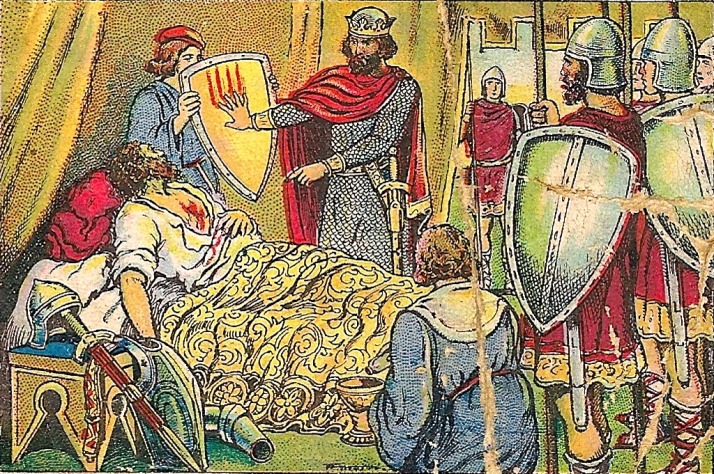
Wilfred the Hairy and “The Four Fingers of Blood” (source: Alfons Cánovas)
By the end of the 9th century, Wilfred the Hairy united the feudal Frankish counties and established the original independent Catalonia. According to legend, as Wilfred was dying from battle injuries, his associate Charles the Bald dipped his fingers into Wilfred’s wound and drew four bloody stripes on a golden shield, creating the Catalán flag.

Besalú and its 12th century Romanesque bridge
Outside Girona, medieval towns and villages built of stone dot the Catalán landscape. To explore the countryside, we visited the well-maintained town of Besalú, and crossed its spectacular 12th century Romanesque bridge.
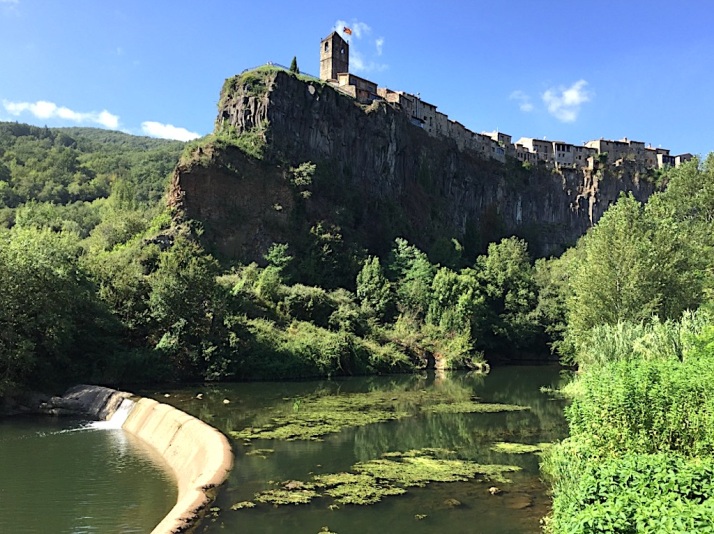
Castellfollit de la Roca on the Fluvià River
Another striking medieval town is Castellfollit de la Roca at the confluence of the Fluvià and Toronell Rivers. The entire place, including its square-sided Romanesque church tower, is perched precariously atop a 165-foot (50 m) high precipice of columnar volcanic basalt.
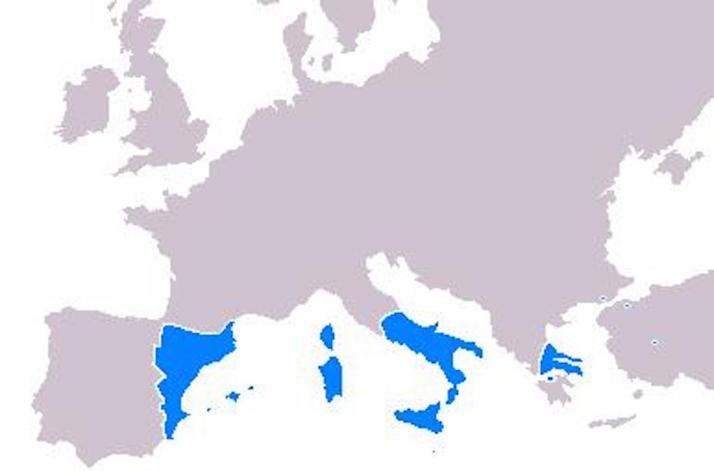
Maximum Extent of the Catalán-Aragonese Empire (source: naplesldm.com)
By the 12th century, Catalonia had united with the Crown of Aragon, and became the base of a powerful sea power. As Catalonia expanded its territory across the western Mediterranean, it became the wealthiest and most important region of the Iberian Peninsula.

Girona’s Medieval Jewish Quarter, The Call
Around this time back in Girona, a community of Jewish citizens was also prospering. With its high stone walls and narrow cobbled streets, Girona’s once-thriving Call neighborhood remains the best preserved medieval Jewish quarter in western Europe.

Celebrating Catalán culture at the Besalú Medieval Fair
In the remarkable year of 1492, the Catholic Monarchs expelled the Jews from Spain, finally defeated the Muslims, and merged Catalonia with the rest of Spain. In exchange, Catalonia retained its autonomy, including its own currency, customs, laws, and language.
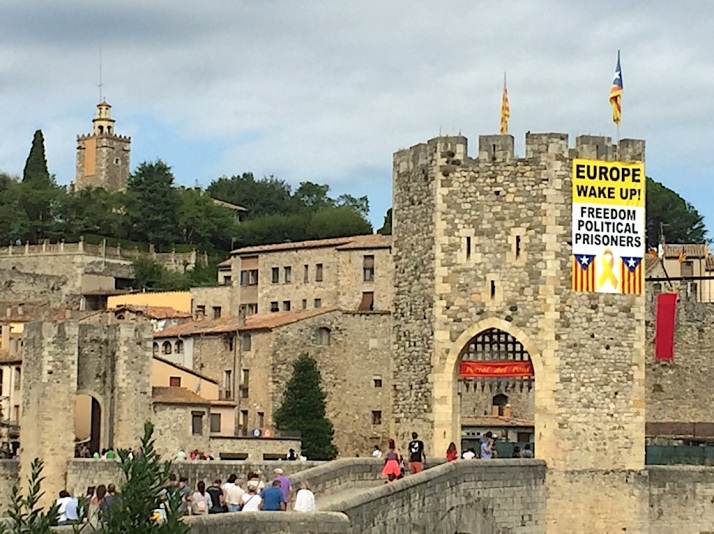
Catalán’s call to free pro-independence leaders, Besalú Bridge
Today, the majority of Cataláns feel they are unfairly shouldering the financial burdens of Spain. But beyond the economics, their appeal for self-determination is based on a long history of autonomy and a fervent cultural pride, deeply embedded in Catalonia’s medieval roots.

Esther and her Unicorn
Feature Image: Yellow ribbon in support of jailed Catalán pro-independence leaders, tied to the Gustave Eiffel Bridge over Griona’s Onyar River.
Blogger’s Note: Next week, we are moving on to the Costa Brava, Catalonia’s rugged coast.
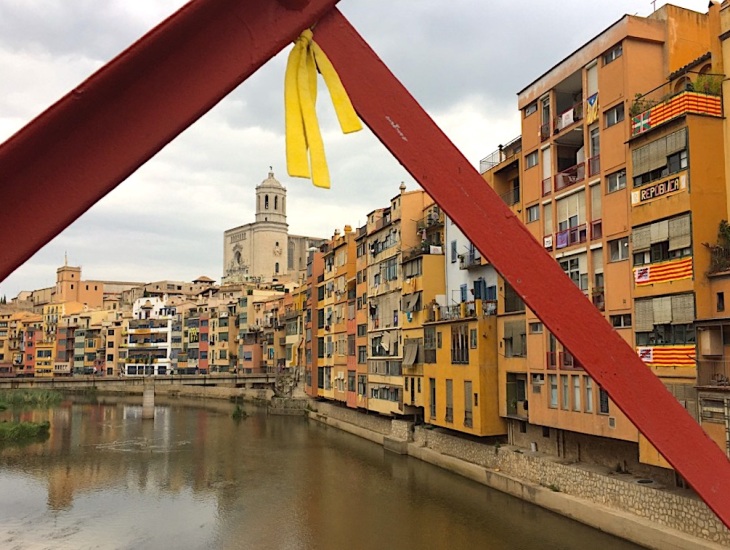
Great post
LikeLiked by 1 person
Thank you! I see from your blog that we are traveling in the same part of the world. I wish you continued enjoyment in the wonderful country of Spain.
LikeLike
I love the history in this, and the design of the Catalan flag is quite original….
LikeLiked by 1 person
Hola Sue and Dave, I never really appreciated Catalonia’s fervent claims of independence until this week. It is such an integral part of the local attitudes and culture. I agree that the creation of the Catalán flag makes a great story, and I had to laugh at the names of the two principals: Wilfred the Hairy and Charles the Bald.
LikeLiked by 1 person
Fascinating history lesson, Joe. Many thanks for taking the time to explain it. Any story with a cat named “Wilfred the Hairy” in it is bound to be worth reading. 🙂 – Marty
LikeLiked by 1 person
Thanks, Marty. It was fun trying to condense 13 centuries into 500 words or less. Wilfred had a pretty beastly nickname, didn’t he? Some of the other more irreverent ones like “Juana the Mad”, “Louis the Stammerer”, and “Henry the Impotent” were not so fortunate. – Joe
LikeLiked by 1 person
Thanks for this in-depth look at the history of Catalonia! I knew they had voted for their independence last year, but didn’t realize the historical significance of that vote. It will be interesting to see how this plays out. And I had no idea so many medieval structures still existed there.
LikeLiked by 1 person
I didn’t realize it either, Ann. I had hoped to learn more about the origin of the Catalán independence movement, and was surprised that it went back so far. Based on the history, I believe that they can make a strong case for independence, but would be surprised if Spain gives them up without a fight. In the meantime, the Cataláns will surely continue to defend their claim and safeguard their many medieval treasures.
LikeLiked by 1 person
Interesting history! Do Catalonians consider themselves political prisoners (referring to the banner)?
I’m curious, did you pull up stakes to move from Barcelona to Girona, or was this a day trip? And, how did you travel (I assume that you haven’t rented a car, but I don’t know for sure)? Of course my questions are to learn more for our future trip… I’m trying to figure out how much time to allow in each place and which places are worth a stop.
LikeLiked by 1 person
Hi Janis, The political prisoners refer to Catalán independence leaders that have been jailed by the Spanish government. We were one week in Barcelona and just scratched the surface. From Barcelona, we traveled by train to Girona (40 minutes), and spent 10 days there. It was not as exciting as Barcelona, but it is a historic smaller city and excellent base for day trips into the countryside. Many people do Girona as a day trip from Barcelona. We are now on the Costa Brava in Platja d’Aro for one week, and the coves, beaches, and coastal trails are spectacular. We have been traveling a lot by public bus, and it has been very easy. On Saturday, we will be renting a car for a week, and driving across the Pyrenees, stopping along the way to hike. We will be returning the car in San Sebastian, where we will be staying an entire month. Happy planning, and let me know if you need any more information.
LikeLiked by 1 person
Wow! How do you choose the place of travel Joe? 🙂
LikeLiked by 1 person
Great question, Deepa. As you well know, the world is full of fun and interesting places to travel. From a practical standpoint, weather, affordability, and public transportation are important factors for us. Most of all, we have chosen travel destinations that we hope will educate us and allow us to pursue our interests (e.g., nature, history, hiking, etc). If you could travel somewhere for a whole month, where would you go?
LikeLike
Yes, those are important aspects to look into when we choose the travel destination. I agree.
If i could choose a place to travel for a whole month, I would either choose to go to the lap of the mighty Himalayas and spend my time there. I really want to see why is it so mystic and divine. Or I would like to follow the river Ganges from the place it originates (which is again the Himalayas) and follow it through its journey right to the place where it meets the Bay Of Bengal.
I know these are not easy trips. They are intense self enquiry trips which I am not ready for yet. But then, someday I shall be..
LikeLiked by 1 person
I am not surprised that your selection of month-long trips would be so grand and full of spiritual discovery. Thank you.
LikeLiked by 1 person
Really! I was all smiles when I read your comment. Thank You.
LikeLiked by 1 person